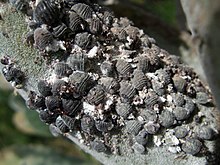Carminic acid
| Structural formula | |||||||||||||||||||
|---|---|---|---|---|---|---|---|---|---|---|---|---|---|---|---|---|---|---|---|

|
|||||||||||||||||||
| General | |||||||||||||||||||
| Surname | Carminic acid | ||||||||||||||||||
| other names | |||||||||||||||||||
| Molecular formula | C 22 H 20 O 13 | ||||||||||||||||||
| Brief description |
scarlet red, odorless solid with a slightly astringent taste. |
||||||||||||||||||
| External identifiers / databases | |||||||||||||||||||
|
|||||||||||||||||||
| properties | |||||||||||||||||||
| Molar mass | 492.38 g mol −1 | ||||||||||||||||||
| Physical state |
firmly |
||||||||||||||||||
| Melting point |
136 ° C ( decomposition ) |
||||||||||||||||||
| solubility |
poor in water (30 g l −1 at 25 ° C) |
||||||||||||||||||
| safety instructions | |||||||||||||||||||
|
|||||||||||||||||||
| As far as possible and customary, SI units are used. Unless otherwise noted, the data given apply to standard conditions . | |||||||||||||||||||
Carminic acid is a chemical compound and the main component of the color carmine . The glucose-free compound is kermess acid .
Chemical structure
Carminic acid is a C-glycoside with an anthraquinone derivative as an aglycon and a glucose as a sugar unit. The sugar is not acetal but is bound to the aglycon via a β-configured carbon-carbon bond . A total synthesis was published in 1991.
Occurrence and extraction
Carminic acid occurs naturally in various scale insects , such as B. the cochineal scale insect ( Dactylopius coccus C. ) and is used by the insect to ward off predators . About 50 g of carmine are obtained from 1 kg of dried cochineal scale insects.
use
Carminic acid, or the coloring agent real carmine, is permitted under the code E 120 as a food coloring agent for certain foods, e.g. sausage, edible coatings on cheese and sausage, jam and spirits, but is only rarely and mainly due to the complex production and allergic reactions that occur used in alcoholic beverages (e.g. Campari ). The synthetic azo dye cochineal red A ( E 124 ) is used as a surrogate . In the cosmetics industry, the dye is still used in lipsticks .
literature
- Franziska Schulze, Juliane Titus, Peter Mettke, Stefan Berger, Hans-Ullrich Siehl, Klaus-Peter Zeller, Dieter Sicker: Carminic acid - the red from cochineal lice . In: Chemistry in Our Time . tape 47 , no. 4 . Wiley-VCH, Weinheim 2013, doi : 10.1002 / ciuz.201300634 .
- Thomas Eisner, Stephen Nowicki, Michael Goetz, Jerrold Meinwald: Red Cochineal Dye (Carminic Acid): Its Role in Nature . In: American Association for the Advancement of Science (Ed.): Science . tape 208 , no. 4447 , 1980, doi : 10.1126 / science.208.4447.1039 .
Individual evidence
- ^ PH List, L. Hörhammer (Ed.): Hager's Handbook of Pharmaceutical Practice . Second volume, active ingredient groups II, chemicals and drugs (A – AL). 4th edition. Springer-Verlag, Berlin, Heidelberg 1969 ( limited preview in Google book search).
- ↑ a b c d data sheet carminic acid (PDF) from Merck , accessed on November 21, 2017.
- ↑ A. Fiecchi, M. Anastasia, G. Galli, P. Gariboldi: Assignment of the β Configuration to the C-Glycosyl Bond in Carminic Acid , in: J. Org. Chem. 1981 , 46 , 1319-1320, doi : 10.1021 / jo00320a061 .
- ↑ P. Allevi, M. Anastasia, P. Ciuffreda, A. Fiecchi, A. Scala, S. Bingham, M. Muir, J. Tyman: The 1st Total Synthesis of Carminic Acid , in: J. Chem. Soc., Chem. Commun. 1991 , 1319-1320; doi : 10.1039 / C39910001319 .
- ↑ Entry on carmine. In: Römpp Online . Georg Thieme Verlag, accessed on June 15, 2016.
- ↑ E. Lück, H. Gölitz, P. Kuhnert: Lexicon of food additives. , 2nd edition, p. 122, Behr's Verlag DE, 1998, ISBN 978-3-86022-462-5 .
- ↑ E 120: Real carmine. Retrieved November 23, 2018 .
